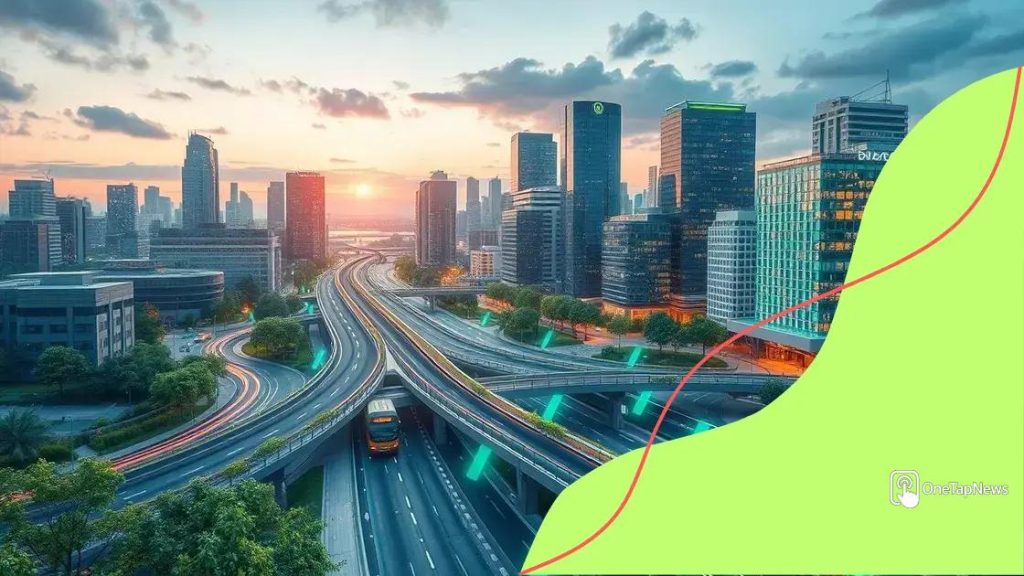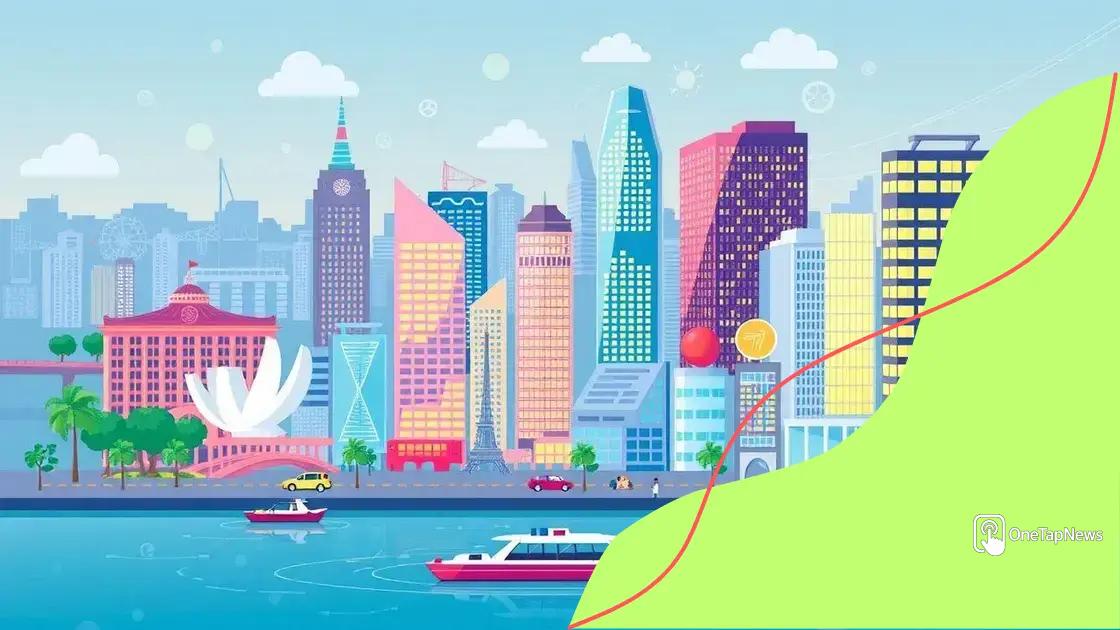Smart city development: transforming urban living

Anúncios
Smart city development focuses on leveraging technology and data to enhance urban living through sustainability, connectivity, and active citizen engagement, addressing contemporary urban challenges effectively.
Smart city development is not just a trend; it’s a revolution in how we experience urban life. From connected streetlights to enhanced public transport systems, these innovations aim to make our cities more efficient and livable. Have you noticed how these changes could impact your daily routine?
Anúncios
What defines a smart city?
Understanding what defines a smart city is essential for grasping the future of urban living. A smart city uses technology to enhance the quality of life for its residents. By leveraging data, cities can manage resources more effectively, leading to a sustainable environment.
Key Characteristics
The characteristics of a smart city revolve around innovation, connectivity, and sustainability. These cities aim to optimize performance across various sectors, including transportation, energy, and communication.
- Connectivity: A robust network infrastructure enables constant communication between devices and systems.
- Data Integration: Using data analytics helps in making informed decisions about urban planning and management.
- Public Services: Enhanced public services improve citizen engagement and satisfaction.
- Sustainability: Eco-friendly initiatives aim to reduce the carbon footprint and increase energy efficiency.
Furthermore, a smart city requires collaboration among stakeholders such as government, businesses, and residents. By working together, they can design a city that is responsive to the needs of its citizens. Smart city development embraces technological advancements to create solutions for everyday challenges.
Anúncios
Technological Foundations
Many technologies contribute to the smart city framework. These include the Internet of Things (IoT), big data, and Artificial Intelligence (AI). These innovations provide insights that drive efficiency and improve urban safety.
The use of sensors and connected devices collects real-time data. Subsequently, this data can optimize traffic flows, manage energy consumption, and enhance public safety measures. With continuous advancements, the possibilities for a smart city are virtually endless, paving the way for a more interconnected world.
Key technologies driving smart city development
Exploring the key technologies driving smart city development reveals how innovation transforms urban environments. These technologies work together to create systems that enhance city living.
Internet of Things (IoT)
The Internet of Things is at the heart of smart city technologies. Through interconnected devices, cities can collect data on everything from traffic patterns to energy use. This real-time data helps in optimizing city services.
- Smart sensors: Monitor air quality and manage waste disposal.
- Connected vehicles: Improve traffic management and reduce congestion.
- Smart homes: Enhance energy efficiency and increase comfort.
As IoT devices communicate with each other, they create a network that helps city planners make informed decisions. This interconnectedness leads to a more responsive urban infrastructure.
Big Data and Analytics
Another essential technology is big data analytics. Cities generate vast amounts of data daily. Properly analyzing this data enables city officials to identify trends and address urban challenges effectively. For instance, data analytics can help reduce crime rates by monitoring hotspots and deploying resources efficiently.
Moreover, predictive analytics can forecast traffic congestion, allowing for better road planning and public transport schedules. By leveraging this technology, cities can enhance overall efficiency and improve the quality of life for their residents.
Artificial Intelligence (AI)
Artificial Intelligence plays a critical role in smart city development. AI algorithms can optimize energy consumption, enhance public safety, and even manage waste collection routes more effectively. With AI, cities can predict problems before they arise, offering solutions to maintain smooth operations.
For example, AI can analyze data from surveillance cameras to identify unusual behavior. Similarly, AI-driven applications assist in creating smarter public transit solutions, which adapt based on real-time usage patterns.
Real-world examples of successful smart cities

Many cities around the world serve as great examples of successful smart cities. These urban areas have embraced technology to enhance living conditions and make services more efficient.
Barcelona, Spain
Barcelona has implemented various smart city initiatives that focus on sustainability and connectivity. The city uses smart sensors to manage street lighting, which leads to energy savings. Additionally, the public transport system provides real-time information, improving the commuter experience.
- Smart waste management: Sensors in bins signal when they need to be emptied.
- Water conservation: Technology helps monitor and reduce water waste.
- Citizen engagement: Apps allow residents to report issues directly to the city council.
This proactive approach has made Barcelona a model for other cities looking to implement smart technologies.
Singapore
Singapore stands out as a leader in smart city development. The government has integrated advanced technology into urban planning, creating a highly efficient ecosystem. The city utilizes an extensive network of sensors and cameras to monitor traffic and manage resources effectively.
With initiatives like the Smart Nation program, Singapore aims to improve urban living and streamline city services. For example, the city has launched digital platforms to facilitate citizen feedback and services.
San Francisco, USA
San Francisco is another prime example, with its focus on innovation. The city has adopted smart traffic management systems that use real-time data to reduce congestion. Additionally, it has implemented green technology for energy efficiency.
Programs like smart streetlights and enhanced public transport apps are well-received by residents. These technologies not only improve convenience but also contribute to environmental sustainability.
As cities continue to evolve, looking at successful smart cities like Barcelona, Singapore, and San Francisco can provide valuable insights for future urban planning.
Challenges in implementing smart city initiatives
Implementing smart city initiatives comes with several challenges that cities must navigate. These obstacles can impact the success and effectiveness of the technologies designed to improve urban life.
High Initial Costs
One of the major challenges is the high initial costs associated with smart city projects. Setting up infrastructure, buying advanced technology, and training staff require substantial investments. Many cities struggle to find the budget to cover these expenses, which can slow down or halt progress.
- Funding sources: Cities may rely on government grants, private investments, or partnerships.
- Long-term planning: Budgeting for maintenance and upgrades is essential to sustain benefits.
- Return on investment: Demonstrating long-term savings can help justify the initial costs.
Despite the financial burden, leaders must consider the long-term benefits these technologies can provide, such as improved efficiency and quality of life.
Data Privacy and Security
Data privacy and security are significant concerns for smart cities. The collection of vast amounts of data often raises questions about how this information is used and who has access to it. Citizens may be wary of how their data is handled.
To mitigate these concerns, cities must establish strict data governance policies. Transparency with residents about data usage is key to building trust.
Interoperability Issues
Another challenge is ensuring the interoperability of different systems and technologies. Smart cities use various devices and software that must work together seamlessly. However, many legacy systems may not be compatible with newer technologies, leading to operational issues.
Additionally, coordination among different city departments can be challenging. Cities need to create standardized protocols to ensure all systems communicate effectively.
By addressing these challenges head-on, cities can better position themselves to successfully implement smart city initiatives. Solutions require collaboration among stakeholders, careful planning, and continued investment in technology.
The future of smart city innovations
The future of smart city innovations looks promising as technology continues to advance. Cities around the world are evolving, using innovative solutions to tackle urban challenges and improve residents’ lives.
Sustainable Practices
One key focus area is sustainability. Future smart cities will adopt green technologies to promote energy efficiency and reduce carbon footprints. From solar panels on buildings to electric public transport systems, the use of renewable energy will grow.
- Green buildings: New constructions will emphasize eco-friendly materials and design.
- Smart grids: These systems will optimize energy distribution and consumption.
- Waste reduction: Advanced recycling technologies will help minimize waste.
By investing in sustainable practices, cities can combat climate change while creating healthier environments for their residents.
Enhanced Connectivity
Enhanced connectivity will also be a major aspect of smart city innovations. With the rise of 5G technology, cities will experience faster internet speeds and improved communication. This will lead to more connected devices that can work seamlessly together.
As a result, services such as traffic management, public safety, and healthcare can operate more efficiently. Cities will use data from connected devices to make real-time decisions that benefit their communities.
Citizen Engagement
Citizens will play a more significant role in shaping their smart cities. Future innovations will focus on citizen engagement, using technology to gather feedback and involve residents in decision-making.
This can include mobile apps for reporting issues or participating in community planning. Engaging residents will help ensure that smart city initiatives meet the actual needs of the people who live there.
In conclusion, the future of smart city innovations is set to bring about remarkable changes. By focusing on sustainability, connectivity, and citizen engagement, cities can become more resilient and responsive to the challenges of urban living.
FAQ – Frequently Asked Questions about Smart City Innovations
What are smart cities?
Smart cities leverage technology and data to improve urban living, enhancing services like transportation, public safety, and energy efficiency.
How do smart cities promote sustainability?
Smart cities focus on eco-friendly technologies, such as renewable energy sources and efficient waste management systems, to reduce their environmental impact.
What role do citizens play in smart city initiatives?
Citizens are actively involved in smart city planning through feedback and participation, ensuring that urban solutions meet their needs.
What challenges do cities face in becoming smart cities?
Cities encounter challenges like high costs, ensuring data privacy, and integrating different technologies as they work towards becoming smarter.